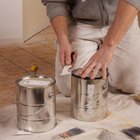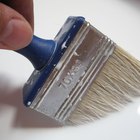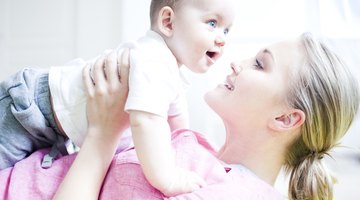Are Paint Vapors Harmful to Infants?
Painting the new nursery is one of the most common tasks on a parents-to-be's to-do list. Although most interior paints sold in stores these days are low-fume or water based to keep the harmful paint vapors at bay, solvent-based paints are still actively bought and sold all over the US.
The vapors from solvent-based paints can cause harm to the unborn child and also the infant who will occupy the room after the painting is finished. The effects of the vapors and the extent of the harm are dependent on a number of factors. By understanding these factors, parents can protect themselves and the infant from the harmful paint fumes.
The Primary Culprit
The ingredients in paints that cause toxic fumes or vapors come from a family of chemicals called VOCs -- volatile organic compound. You can identify them in paint by what the Minnesota Department of Health calls a sweet smell that is characteristic of house solvent-based house paint. These compounds adhere to dust and food. They can also dissolve in the air as well as water. In a ventilated room, the VOCs are easily broken down by sunlight and microorganisms in the air that feed of the chemicals, according to the MDH. However, when the paint is drying or containers are open, the fumes escape and contaminate the air and objects within the room.
How Infants Are Harmed

Health Effects on Babies Breathing Oil-Based Paints
Learn More
The MDH states that people take in VOCs by breathing in the vapors, touching slightly wet paint on the walls, eating food contaminated by VOC vapors and breathing in dust on which the compounds have adhered. A baby left to sleep in a freshly painted room can easily breath in the toxic compounds, especially if the room hasn't been properly ventilated or the paint allowed to dry. Fortunately, once the vapors dissipate or are broken down and are no longer harmful, there is no further harm to be done to the infant. Short-term exposure may cause irritated lungs, coughs and other respiratory troubles. Eye irritation is also a complaint. These symptoms go away once the exposure is stopped.
Prolonged Exposure
Infants who sleep in rooms near open paint containers or those who stay in rooms are even in danger. The room still contains remnants of the VOCs in the form of dust that bonded with the compound while it was wet. More particles are present if the room is improperly ventilated. The air becomes saturated with the VOCs, even if they break down in the air.
Ingested paint can also cause prolonged exposure symptoms like increased cancer risk, respiratory problems, renal issues and allergic reactions, according to the U.S. Environmental Protection Agency. Infants can develop problems such as asthma, skins condition and cancer that will affect them much later in life.
Preventing Harm

The Effects of Paint Fumes on Pregnancy
Learn More
Fortunately, it is not difficult to prevent exposure to VOCs and harmful paint vapors. Keep the infant out of the room until the paint has been properly dried and the room ventilated.
Then, vacuum the carpets, and dust the surfaces of the furniture left in the room. Curtains should be washed as well. The result is a room free of VOCs and VOC-bonded particles in the air.











